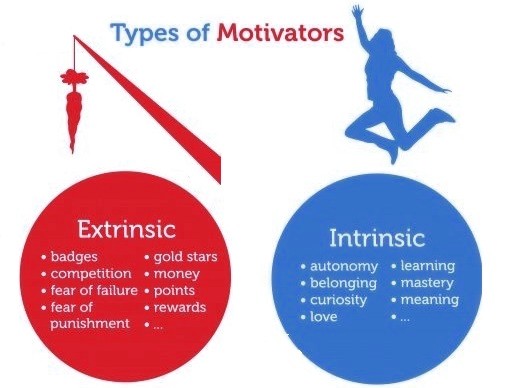Motivation is a crucial factor in anyone's life - it builds determination and ambition and helps us to be successful. In scientific terms, it’s a psychological force that drives us to achieve specific goals, and it plays a pivotal role in education. Without motivation, we would have little chance of succeeding in any task. This is never more apparent than in the classroom. Extrinsic and intrinsic motivation shape how students interact with their learning environment, affecting their academic success and overall wellbeing. Our previous article, The Psychology of Recognition in Education, discussed how educators can recognise and harness motivation to improve student outcomes. This article aims to differentiate between the two primary types of motivation - extrinsic and intrinsic - and examines their applications in educational settings.
The Basics of Motivation
Within an educational setting, motivation is the psychological force that energises, directs, and sustains behaviour geared towards academic achievement and personal development. It’s essentially the central factor that helps students strive for better results and more meaningful engagement, leading to a rewarding and successful learning experience. Critical studies have laid the foundation for our understanding of motivation. Notably, the Self-Determination Theory by Deci & Ryan (1985) differentiates motivation into autonomous and controlled types. According to the theory, autonomy-supportive environments are conducive to fostering intrinsic motivation, whereas controlled environments generally promote extrinsic motivation. These insights have significant consequences for how educational institutions approach motivation to meet compliance and enhance the quality of education that they provide.
Extrinsic Motivation
Extrinsic motivation refers to behaviours that are driven by external rewards or outcomes, such as praise, good grades or physical rewards. In educational settings, extrinsic motivators are often heavily relied on to increase student engagement, particularly when intrinsic interest in a subject is low. Typical forms of extrinsic motivation in schools can range from a gold star for good behaviour to being recognised in a school assembly.  The effectiveness of extrinsic motivators has been widely studied. Research by Deci, Koestner, and Ryan in 1999 found that extrinsic rewards can be effective for tasks requiring limited cognitive engagement. However, they may undermine intrinsic motivation in complex tasks or creative thinking. This can lead to the Overjustification Effect, where external rewards reduce internal drive. For educators, it's essential to understand the impact that external rewards can have on students' internal motivations, both for better and worse. For example, while grades and recognition can drive short-term performance, they will rarely translate to a sustained love for learning or mastery of a subject. We explore this topic more in The Overjustification Effect and its Impact on Education.
The effectiveness of extrinsic motivators has been widely studied. Research by Deci, Koestner, and Ryan in 1999 found that extrinsic rewards can be effective for tasks requiring limited cognitive engagement. However, they may undermine intrinsic motivation in complex tasks or creative thinking. This can lead to the Overjustification Effect, where external rewards reduce internal drive. For educators, it's essential to understand the impact that external rewards can have on students' internal motivations, both for better and worse. For example, while grades and recognition can drive short-term performance, they will rarely translate to a sustained love for learning or mastery of a subject. We explore this topic more in The Overjustification Effect and its Impact on Education.
Intrinsic Motivation
In contrast to extrinsic motivation, intrinsic motivation comes from within. It is driven by internal, less tangible rewards such as a sense of accomplishment or the joy of learning. Types of intrinsic motivation can be broken down into several categories, including mastery, where the individual is motivated by the desire to become proficient in a particular subject; curiosity, which involves the drive to explore and understand; and relevance, the motivation stemming from the individual’s perception of the task's significance in their life or future. In educational environments, this motivation often develops when the topic of learning is linked to personal interests, creates curiosity, or offers a sense of purpose. Studies have been unequivocal about the long-term benefits of intrinsic motivation. A landmark study by Gagné and Deci in 2005 revealed that intrinsically motivated students show better academic performance, greater emotional well-being, and a higher degree of engagement in the learning process.

Applications in Education
In education, extrinsic and intrinsic motivations both have their respective places. To unlock the full potential of your students, it's crucial to understand and effectively utilise both types of motivation. For example, in a traditional classroom setting, students often receive grades or stickers as rewards for good performance (extrinsic motivation). However, those who already excel in the topic may be driven by their mastery of it or enjoy it purely because they're interested in the topic (intrinsic motivation). These types of motivation can co-exist harmoniously but can also conflict at times. According to educational best practices, such as those outlined by the Department for Education, striking a balance is essential. Too much reliance on extrinsic motivators, like grades or awards, can undermine intrinsic motivation. Conversely, solely focusing on intrinsic motivators might not offer the immediate encouragement some students need to kick-start their learning journey. So, how can educators balance the two? Incorporating elements like "gamified" learning can serve both extrinsic and intrinsic ends. On one hand, the points or badges earned cater to extrinsic motivations, while the joy of problem-solving serves intrinsic goals.

Motivation in Action: A Case Study
A fascinating year-long study at a primary school looked into the effects of using both extrinsic and intrinsic motivational strategies. The goal was to boost student involvement and their academic achievements. Teachers introduced rewards like certificates and special classroom benefits for reaching certain goals (extrinsic motivation). At the same time, they initiated a daily program called “Question of the Day” to encourage thinking and curiosity (intrinsic motivation). The results were impressive. Student participation and academic results saw a significant uptick. Even students who previously showed little interest started to engage actively to gain rewards. The “Question of the Day” fostered lively discussions, cultivating an environment of curiosity and learning from each other. While the immediate impact of extrinsic motivators was clear, their effectiveness seemed to lessen over time. Conversely, intrinsic motivators like the daily question not only maintained interest but actually grew more effective throughout the study. This case study highlights an important lesson: while extrinsic motivators are good at sparking initial interest, they should be used thoughtfully to avoid dampening self-motivation. The most effective approach for sustained educational engagement seems to be a balanced combination of both extrinsic and intrinsic motivation.
In Conclusion
Understanding the interplay between extrinsic and intrinsic motivation is pivotal for enhancing the quality of education. While extrinsic motivators can serve as valuable tools for immediate behavioural change, intrinsic motivation often leads to sustained, self-directed learning. If managed judiciously, the delicate balance between the two can significantly enrich educational outcomes and student well-being.
Recommended Reading & Resources
- Drive: The Surprising Truth About What Motivates Us by Daniel H. Pink - A thought-provoking look into what truly motivates us, including in educational settings.
- Self-Determination Theory: Basic Psychological Needs in Motivation, Development, and Wellness by Richard M. Ryan & Edward L. Deci - The seminal book on Self-Determination Theory.
- Punished by Rewards by Alfie Kohn - An exploration of the pitfalls of extrinsic motivation.
- Mindset: The New Psychology of Success by Carol S. Dweck - A study on how our mindset affects motivation.
- The Element: How Finding Your Passion Changes Everything by Ken Robinson - Discusses the role of intrinsic motivation in finding one's passion.
- Flow: The Psychology of Optimal Experience by Mihaly Csikszentmihalyi - An investigation into states of 'flow' or optimal intrinsic motivation.
- The Motivated Brain by Gayle Gregory and Martha Kaufeldt - Examines how to tap into intrinsic motivation for effective learning.
- NurtureShock: New Thinking About Children by Po Bronson and Ashley Merryman - Challenges conventional wisdom, including beliefs about motivation.
- The Art of Choosing by Sheena Iyengar - Discusses the psychology of choice, linking closely with aspects of intrinsic motivation.

